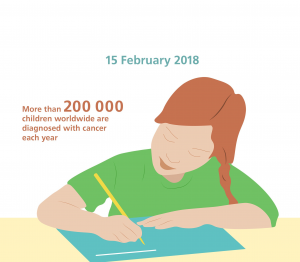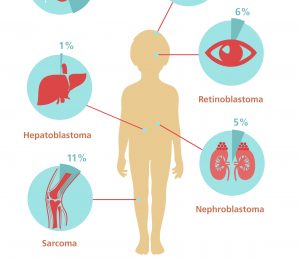15/02/2018
International Childhood Cancer Day 2018
Each year, more than 200 000 children worldwide are diagnosed with cancer. Although in high-income countries about 80% of children with cancer survive for at least 5 years after the diagnosis, this percentage is much lower for patients in low-resource settings. Raising awareness, notably among medical professionals in countries with many competing public health needs, is indispensable to promote early diagnosis and access to adapted treatment. The International Agency for Research on Cancer (IARC) works closely with cancer registries and partners around the world to generate and provide global data, which are essential for developing and monitoring efficient strategies of early detection and care for children with cancer.
View IICC project website
Interview with Dr Eva Steliarova-Foucher, a scientist in the Section of Cancer Surveillance at the International Agency for Research on Cancer (IARC).
What is the International Incidence of Childhood Cancer (IICC) project?
The aim of the IICC project is to provide comparable and quality assured data on the incidence of cancer among young people under the age of 20 years.
How does IARC collaborate with partners to collect these data?
IARC relies on the active participation of population-based cancer registries, which collect data on new cancer cases in defined geographical areas over many calendar years. The registries share some of the information they collect in a standardized format, and their data are centrally assessed by an expert group. This collaboration increases data comparability, because all contributors must comply with standard criteria. As a result of this international collaboration, the local data and information inevitably improve.
Why are these data often “neglected”?
Children with cancer represent a small proportion of the total number of cancer patients; this proportion may be 0.5% in high-income countries and up to 5% in very low income countries. Furthermore, the causes of cancer in children are unknown, and there are no recommended preventive strategies. In low-income countries, cancer is not perceived as a high-priority health threat in general, and even less so in children. However, these same reasons should also be a driving force for more research. In the field of childhood cancer, international collaboration is essential, to increase study size, to integrate data variability, and to improve the quality of the information.
Why are these data important to tackle childhood cancer, and how can they be used?
The data generated through this large-scale collaboration quantify the problem and help in setting public health priorities. Regular updates measure progress. Without these numbers, planning and budgeting for care distribution is not possible. For example, studying variations in occurrence may reveal favouritism of boys over girls in some populations. Different cancer incidence rates in the same ethnic group in different countries may suggest environmental risk factors, whereas differences in incidence between ethnic populations living in the same country may be linked to genetic factors. Low cancer incidence may indicate a low risk, but it may also be a sign of inefficient diagnostics or poor access to health care. The collected data have multiple uses and are therefore of great value to researchers, to medical professionals, to policy-makers, and to patients′ organizations.
What are the key challenges in collecting these data?
In many countries and areas, the resources available for cancer registration in general are insufficient. The data are expected to be available, but quality has a cost, and for the data to be of use, they must represent the reality and must be comparable internationally and over time. Cancer is low on the agenda of many low-income countries. Even where cancer registration is supported, the activities and attention are devoted to cancer types that affect large numbers of patients. This may explain why a number of specialized paediatric cancer registries have been established, to serve specifically the population of children. However, at present the proportion of the global population covered by cancer registration is only about 10%, and this is heavily weighted towards high-income countries. Many low-income countries, for example those in Africa, have no idea of the extent of the cancer burden they face.
What do you hope for the future?
I would like to see reliable data on the cancer burden for at least 50% of the global childhood population. And I hope that these data will one day start showing a rapid annual decline in incidence rates, due to ever-improving health conditions and successful prevention strategies.
Infographics
International Childhood Cancer Day 2018
 View |
 View |
Related Links
Related Links
- International incidence of childhood cancer, 2001–10: a population-based registry study
An international study coordinated by the International Agency for Research on Cancer (IARC) and published in The Lancet Oncology shows that in 2001–2010, childhood cancer was 13% more common than in the 1980s, reaching an annual incidence rate of 140 per million children aged 0–14 years worldwide.
Steliarova-Foucher E, Colombet M, Ries LAG, Moreno F, Dolya A, Bray F, Hesseling P, Shin HY, Stiller CA, and the IICC-3 contributors. International incidence of childhood cancer, 2001–10: a population-based registry study. Lancet Oncol. Published online 11 April 2017.
Read article, Read IARC Press Release 251
- Les cancers chez les enfants ont augmenté de 13% dans le monde entre les années 1980 et 2000, selon une étude coordonnée par le Centre international de recherche sur le cancer (CIRC)
Read
- Childhood cancer trends: how to interpret new findings
Dr Eva Steliarova, Scientist at IARC′s Section of Cancer Surveillance interviewed by UN Radio, explains how research results can be used to reduce the burden of cancer in children
Read
- Can data address the burden of childhood cancer?
Véronique Terrasse, Press Officer at the International Agency for Research on Cancer (IARC), outlines to AG how high-quality data is critical for tackling childhood cancer globally…
Read
- Late effects of childhood cancer: comprehensively estimating the complete burden of disease
In a Comment published in The Lancet, Dr Miranda Fidler, a postdoctoral fellow at the International Agency for Research on Cancer (IARC), stresses the importance of such comprehensive assessments of chronic health conditions among survivors of childhood cancer, in order to better address their complex health-care needs.
Read
